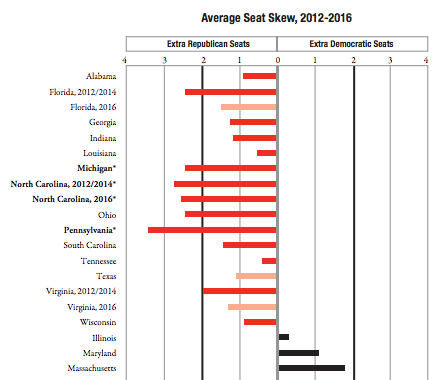Pennsylvania’s Extreme Maps
On May 9 the Brennan Center for Justice released a report applying new standards of fairness to congressional district maps across the United States.
Extreme Maps draws on data from election cycles since the 2011 redistricting to show which states have suffered the worst gerrymandering abuses. The report illuminates the way specific state processes contribute to extreme partisan skew in just a handful of states.

Just seven states account for almost all partisan bias, with three consistently most extreme: North Carolina, Michigan and Pennsylvania.
By two measures, Pennsylvania is without question the worst offender. By both the efficiency gap standard and the seats-to-votes skew, PA’s maps are about 25 percent more extreme than those of North Carolina, the next in line for worst maps in the nation.
By the third measure, mean-median difference analysis, Pennsylvania again out-gerrymanders North Carolina, but falls slightly behind Florida and Ohio, depending on the year.
According to the report, “maps drawn by independent commissions, courts, or split-party state governments had significantly less partisan bias in their maps.”
Authors Laura Royden and Michael Li offer a warning:
There is clear evidence that aggressive gerrymandering is distorting the nation’s congressional maps, resulting in both large and remarkably durable levels of partisan bias. The rise of extreme gerrymandering, enabled by more accurate political data and better map-drawing software, seems poised to continue if left unchecked, allowing parties to manipulate maps to lock in a guaranteed artificial advantage for themselves. The threat to democracy is both real and alarming.